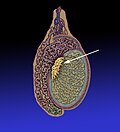Rete testis
(REE-tee TES-tis) is a network of small tubes in the testicle that helps move sperm cells (male reproductive cells) from the testicle to the epididymis. The epididymis is where the sperm mature and are stored.
Overview[edit]
The rete testis is an intricate network of interconnected tubules located within the testicles that play a crucial role in the male reproductive system. Its primary function is to transport sperm from the seminiferous tubules, where they are produced, to the Epididymis, where they undergo maturation and are stored until ejaculation.
Anatomy and Function[edit]
The rete testis is situated in the mediastinum testis, a structure within the testicle. It is formed by the convergence of the seminiferous tubules, which are the site of spermatogenesis (sperm production).
Structure[edit]
- Seminiferous tubules - Narrow, coiled tubules where sperm are generated.
- Mediastinum testis - Central connective tissue of the testicle where the rete testis is located.
- Efferent ductules - Channels that connect the rete testis to the epididymis.
Sperm Maturation and Transport[edit]
- Sperm maturation - Sperm cells are transported from the seminiferous tubules through the rete testis and efferent ductules to the epididymis, where they gain motility and fertilizing capability.
- Sperm storage - The epididymis is a long, coiled tube attached to the back of each testicle where sperm are stored and further matured.
Clinical Significance[edit]
The rete testis is vital for male fertility. Any obstruction or malformation within these tubes can lead to conditions such as:
- Azoospermia - Absence of sperm in semen, potentially caused by blockage in the rete testis.
- Epididymitis - Inflammation of the epididymis, which can also affect the rete testis.
Medical Imaging and Diagnosis[edit]
Conditions affecting the rete testis may be diagnosed using medical imaging techniques such as:
- Ultrasound - Often used to assess the structure and function of the rete testis.
- MRI Scans - Can provide detailed images of the testicular anatomy.
Treatment and Management[edit]
Treatment for conditions affecting the rete testis depends on the underlying cause but may include:
- Surgery - To remove blockages or repair damage.
- Antibiotics - If an infection is present.
- Assisted Reproductive Technologies - Such as IVF or ICSI, for issues with sperm transport or maturation.
Research and Advances[edit]
Continued research in the field of Andrology and reproductive health aims to better understand the rete testis's role in fertility and develop treatments for related conditions.
Ad. Transform your life with W8MD's Budget GLP-1 injections from $75


W8MD offers a medical weight loss program to lose weight in Philadelphia. Our physician-supervised medical weight loss provides:
- Weight loss injections in NYC (generic and brand names):
- Zepbound / Mounjaro, Wegovy / Ozempic, Saxenda
- Most insurances accepted or discounted self-pay rates. We will obtain insurance prior authorizations if needed.
- Generic GLP1 weight loss injections from $75 for the starting dose.
- Also offer prescription weight loss medications including Phentermine, Qsymia, Diethylpropion, Contrave etc.
NYC weight loss doctor appointmentsNYC weight loss doctor appointments
Start your NYC weight loss journey today at our NYC medical weight loss and Philadelphia medical weight loss clinics.
- Call 718-946-5500 to lose weight in NYC or for medical weight loss in Philadelphia 215-676-2334.
- Tags:NYC medical weight loss, Philadelphia lose weight Zepbound NYC, Budget GLP1 weight loss injections, Wegovy Philadelphia, Wegovy NYC, Philadelphia medical weight loss, Brookly weight loss and Wegovy NYC
|
WikiMD's Wellness Encyclopedia |
| Let Food Be Thy Medicine Medicine Thy Food - Hippocrates |
Medical Disclaimer: WikiMD is not a substitute for professional medical advice. The information on WikiMD is provided as an information resource only, may be incorrect, outdated or misleading, and is not to be used or relied on for any diagnostic or treatment purposes. Please consult your health care provider before making any healthcare decisions or for guidance about a specific medical condition. WikiMD expressly disclaims responsibility, and shall have no liability, for any damages, loss, injury, or liability whatsoever suffered as a result of your reliance on the information contained in this site. By visiting this site you agree to the foregoing terms and conditions, which may from time to time be changed or supplemented by WikiMD. If you do not agree to the foregoing terms and conditions, you should not enter or use this site. See full disclaimer.
Credits:Most images are courtesy of Wikimedia commons, and templates, categories Wikipedia, licensed under CC BY SA or similar.
Translate this page: - East Asian
中文,
日本,
한국어,
South Asian
हिन्दी,
தமிழ்,
తెలుగు,
Urdu,
ಕನ್ನಡ,
Southeast Asian
Indonesian,
Vietnamese,
Thai,
မြန်မာဘာသာ,
বাংলা
European
español,
Deutsch,
français,
Greek,
português do Brasil,
polski,
română,
русский,
Nederlands,
norsk,
svenska,
suomi,
Italian
Middle Eastern & African
عربى,
Turkish,
Persian,
Hebrew,
Afrikaans,
isiZulu,
Kiswahili,
Other
Bulgarian,
Hungarian,
Czech,
Swedish,
മലയാളം,
मराठी,
ਪੰਜਾਬੀ,
ગુજરાતી,
Portuguese,
Ukrainian








